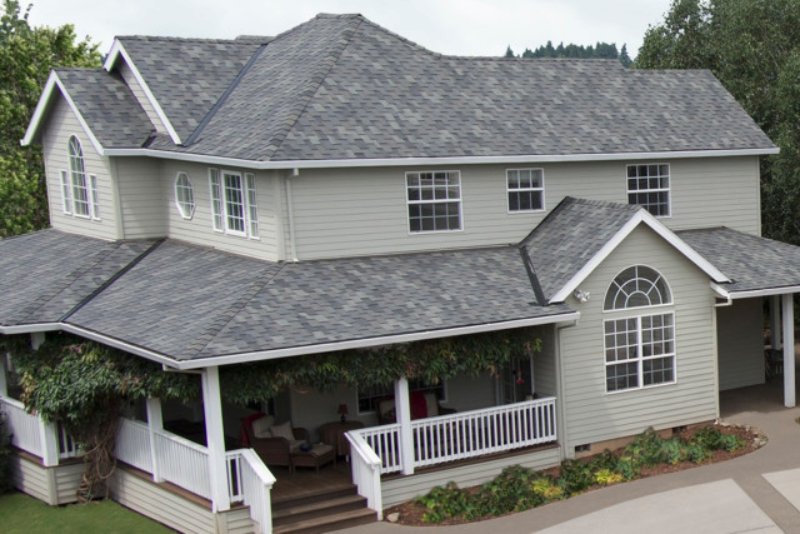In order to truly understand the residential roofing system, you must first be introduced to the 3 most common types of roofs. We see them all the time and do not know their names. We’ll then delve into defining the 7 main roofing elements that make up the general structure of a residential roof. We will also explore the main residential roofing services homeowners request.
Contact R.B. & Sons for the Best Residential Roofing Services Utah has to offer. Our team of experienced and insured roofers can help you with all of your roofing needs.
The 3 Celebrity Roof Types
1.Gable Roofs
This type of roof is the one that we are most accustomed to seeing. It’s the type of roof that when asked to illustrate, we draw as a triangle almost 100% of the time. They are also known as peaks roofs for their triangular outlining shape.
A gable roof is fairly simple when you consider the design making it more economical and effortless during the process of construction. They are the preferred roof top choice because they are built on an angle and can shed snow more easily during the winter season.
2.Flat Roofs
These type of Roofs are most commonly found in commercial buildings but are also used in modern condominiums. Though they do feature a flat surface as their namesake correctly suggests, they do have a minor dip, in order to gather and drain excess water.
When you need Apartment & Condo Roofing Utah suggests R.B. Sons as your go-to contractors.
3.Bonnet Roofs
The main visual characteristic of a bonnet roof is that it has twin slopes that incline different angles. The first higher slope is typically found in the residential homes that have attics or slanted ceilings and the lower slope hangs over the side and can provide a covering over your front porch.
Let’s Define the 7 Main Roof Components
1.Trusses
Trusses are the backbone (foundation) of a roof system. Typically built from wood, it is a famed structure that is comprised of those famous triangle-shaped joints that provide stable roofing support. They are durable and built to withstand severe weather like heavy amounts of snow and rain.
2.Roof Deck
The roof deck is the second layer of material that is used to cover the truss foundation. The roof deck can be made of plywood, OSB sheathing, wood tongue and groove, corrugated metal, or a variety of high-quality materials that a professional roofer may recommend and is the layer that helps unite all the other roofing components together.
3.Underlayment
The underlayment. This layer is perhaps the most essential component of a roof as it is the waterproofing layer that is added to keep water and other forms of moisture from penetrating through the roof.
4.Flashing
The second waterproof layer we add is the flashing. This layer is made up of sheet metal material or rigid pliable materials. All residential homes that have vents, jacks, and especially fireplaces that penetrate the roof should have and normally do have a flash layer for extra added protection.
5.Drainage
The main function of any roof is to protect from the outdoor weather elements. Any and all roofing types should have a slope feature to help drain water off the roof. Drainage much like flashing is an essential component as it’s purpose is to shed water, keeping your roof dry so your roof system is functioning for many years.
6.Ventilation
Just as an air conditioner gives cool air and takes away the moisture on a hot day, a roof breathes in cool fresh air and lets out warm, moist air. There are a multitude of vents, pipes, and screened openings and their main functionality is to allow air to flow in and out of a roof’s attic space.
7.Roof Covering
And last but certainly not least is the final layer, the roof covering. Depending on the type of residential home you have, this final layer may consist of tile, metal and most commonly shingles. of course the materials chosen as the final roof covering all the other layers can largely effect the strength and durability of the overall roof. Contact a professional roof contractor for a more in depth opinion on which roof covering is best for your residential home.
Homeowners Request these Residential Roofing Services Most Frequently
Roof Installations
This is not a service that is requested for existing homes. This residential roofing service is undoubtedly done at the time the house is being built. Just as an old roof should be inspected, professionals recommend that new roof installations be inspected every so often to make sure the roof is in optimal condition from the start.
Roof Repairs
This of course is the most common of the 4 roofing services. Residential Roofing repairs is an umbrella service that can include different repairs such as: shingle replacement, sagging roof repair and roof leak repairs.
Roof Replacements
As a homeowner, of course you never give up home that the leaky roof can be repaired rather than replaced but sometimes, it is just that time, your roof is beyond being able to be repaired and therefore a full roof replacement is required. Though this option may cost more, in the long run, you’ll e happy you did it as a residential roof replacement left undone, can cause further damages to the interior of your home. Roof replacements are typically recommended when your roof is 25 years or older. When that time comes, be sure to contact experienced professional and insured residential roof contractors you can trust.
After installation, be sure to book an appointment to get the moss removed from your brand new roof. Ever wondered, “What is the Best Time of Year to Remove Moss From Roof” ? Despite you feeling like, any time of year is good, there is an answer and a specific time of year.

